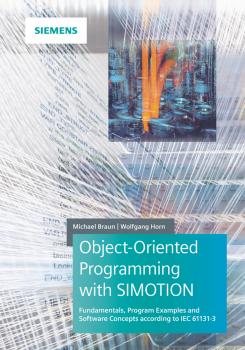ТОП просматриваемых книг сайта:
Michael Braun
Список книг автора Michael BraunObjektorientiertes Programmieren mit SIMOTION. Grundlagen, Programmbeispiele und Softwarekonzepte nach IEC 61131-3 - Michael Braun
Аннотация
Die Tendenz im Maschinenbau hin zu immer flexibleren Losungen fuhrt auch zu Veranderungen bei den Steuerungen. Mit der Zunahme mechatronischer Systeme und modularer Funktionseinheiten ergeben sich hohe Anforderungen an die Software und deren Programmierung. In der Automatisierungstechnik wird daher in den nachsten Jahren der gleiche Wandel stattfinden, der in der PC-Welt bereits erfolgt ist, hin zu besserem und klarerem Softwaredesign, zu einfacher Anderbarkeit und Modularitat. Dafur brauchen wir Objektorientierte Programmierung. Das Buch richtet sich an alle, die sich mit dieser zukunftsweisenden Entwicklung in der Automatisierungstechnik vertraut machen mochten. Egal ob man angehender Ingenieur, Techniker oder erfahrener Automatisierungstechniker ist: Es hilft, die Objektorientierte Programmierung zu verstehen und anzuwenden. SIMOTION stellt ab Softwarestand 4.5 die Moglichkeit der Nutzung von OOP entsprechend IEC 61131-3 ED3, der Norm fur speicherprogrammierbare Steuerungen, zur Verfugung. Das Buch unterstutzt den Umgang mit dieser Denk- und Programmierweise und bietet Programmierbeispiele zu verschiedenen objektorientierten Techniken und den dabei wirkenden Mechanismen. Die Beispiele sind aufeinander aufbauend gestaltet, so dass am Ende ein komplettes, verwendbares Maschinenmodul entsteht.
Object-Oriented Programming with SIMOTION. Fundamentals, Program Examples and Software Concepts According to IEC 61131-3 - Michael Braun
Аннотация
In mechanical engineering the trend towards increasingly flexible solutions is leading to changes in control systems. The growth of mechatronic systems and modular functional units is placing high demands on software and its design. In the coming years, automation technology will experience the same transition that has already taken place in the PC world: a transition to more advanced and reproducible software design, simpler modification, and increasing modularity. This can only be achieved through object-oriented programming. This book is aimed at those who want to familiarize themselves with this development in automation technology. Whether mechanical engineers, technicians, or experienced automation engineers, it can help readers to understand and use object-oriented programming. From version 4.5, SIMOTION provides the option to use OOP in accordance with IEC 61131-3 ED3, the standard for programmable logic controllers. The book supports this way of thinking and programming and offers examples of various object-oriented techniques and their mechanisms. The examples are designed as a step-by-step process that produces a finished, ready-to-use machine module. Contents: Developments in the field of control engineering – General principles of object-oriented programming – Function blocks, methods, classes, interfaces – Modular software concepts – Object-oriented design, reusable and easy-to-maintain software, organizational and legal aspects, software tests – I/O references, namespaces, general references – Classes in SIMOTION, instantiation of classes and function blocks, compatible and efficient software – Introduction to SIMOTION and SIMOTION SCOUT.
Аннотация
A unique collaboration featuring the latest methodologies and research on multi- and cross-national surveys Over the past two decades, the relevance of cross-national and cross-cultural methodologies has heightened across various fields of study. Responding to increasing cultural diversity and rapid changes in how research is conducted, Survey Methods in Multinational, Multiregional, and Multicultural Contexts addresses the need for refined tools and improved procedures in cross-cultural and cross-national studies worldwide. Based on research submitted to the International Conference on Multinational, Multicultural, and Multiregional Survey Methods (3MC), this book identifies important changes in comparative methodology approaches, outlines new findings, and provides insight into future developments in the field. Some of the world's leading survey researchers gather in this volume to address the need for a standard framework that promotes quality assurance and quality control in survey research, and its impact on various stages of the survey life cycle, including study design and organization, cross-national sampling, testing and pretesting, data collection, and input and output variable harmonization. Self-contained chapters feature coverage of various topics, such as: Question and questionnaire design, from both global and study-specific perspectives The construction and evaluation of survey translations and instrument adaptations The effects of cultural difference on the perception of question and response categories Non-response issues Analysis in comparative contexts, featuring discussion of polytomous item response theory, categorization problems, and Multi-Trait-Multi-Methods (MTMM) The significance of evolving methodologies for current international survey programs, including the European Social Survey, the International Social Survey Programme, and the Gallup World Poll Survey Methods in Multinational, Multiregional, and Multicultural Contexts is a valuable supplement for courses on comparative survey methods at the upper-undergraduate and graduate levels. It also serves as an insightful reference for professionals who design, implement, and analyze comparative research in the areas of business, public health, and the social and behavioral sciences.



